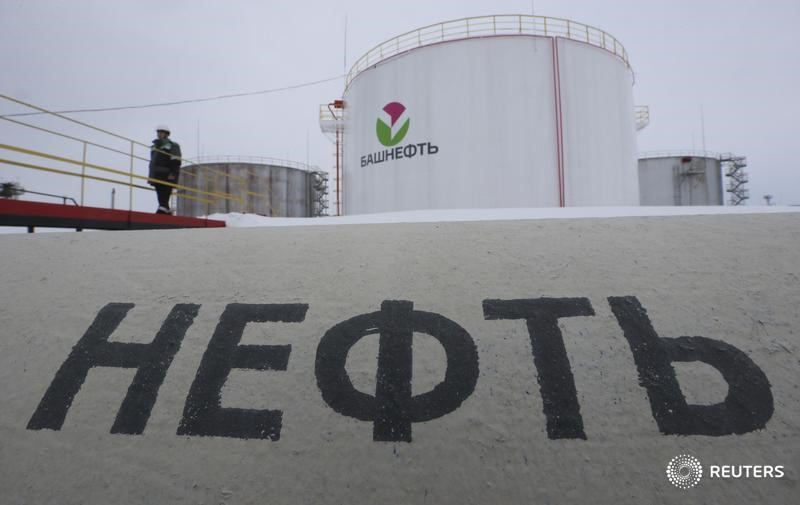By Barani Krishnan
Investing.com -- Another week, another big U.S. crude build, and another positive close on the oil market, which seems to prefer catching up a day or two later to the fact.
The Energy Information Administration reported on Thursday a ninth straight weekly rise in U.S. crude stockpiles that left the market with 60 million barrels more than at the start of the year.
Oil bulls, however, pushed the data aside to focus on a Reuters report that Russia plans to cut crude exports from its western ports by up to 25% in March versus February. The proposed reduction in Russian oil output for next month would be in excess of the 5% production cut announced for February by Deputy Prime Minister Alexander Novak a couple of weeks ago.
Like most news out of Moscow that needs verification, the Reuters report was lacking in proof, with both the Russian energy ministry and oil pipeline monopoly Transneft declining to comment.
Pushed against the wall by Ukraine-related sanctions imposed by the West, the Kremlin has come out fighting with statements aimed at striking back at its political foes while upholding its sovereignty as well as the prices of its main export oil, which has been battered by a $60 selling limit imposed by the G7. Often, however, the Kremlin’s statements have been more bravado than action.
Russia normally exports up to 10M tonnes a month or 2.5M barrels per day of Urals crude from the ports of Primorsk, Ust-Luga and Novorossiysk. A cut of 25% would represent as much as 625,000 bpd if confirmed by Transneft and agreed to by oil companies, said Reuters which cited anonymous sources for its report.
Despite the lack of authoritative sourcing, the story was enough to help crude prices rise 2% on the day, recovering a large part of Wednesday's 3% tumble.
New York-traded West Texas Intermediate, or WTI, crude for March delivery settled up $1.44, or 2%, at $ 75.359 per barrel. It fell 3.4% in the prior session.
Brent for April delivery settled up $1.61, or 2%, at $82.21. Like WTI, Brent also fell 3% a day ago.
Crude inventories gained 7.648M barrels during the week ended Feb. 17, the EIA said in its Weekly Petroleum Status Report. That extended the prior week's outsized build of 16.283M barrels, which was the fourth largest ever in the history of the agency’s reporting.
In total, some 850.6M barrels were stockpiled at the end of last week and of that, around 60M, or 7%, were built over eight straight weeks, beginning from the week ended Jan. 3.
For last week itself, industry analysts had forecast a build of 2.083M barrels on the average. The EIA reported almost three times that number
The climb in crude inventories comes amid seasonal maintenance and other disruptions at U.S. refineries that foresaw less processing of crude.
The EIA said U.S. crude oil refinery inputs averaged 15M barrels per day last week, which was 17,000 barrels per day less than the previous week’s average.
Refineries operated at 85.9% of their operable capacity last week, the agency added. Typically, inventory runs at this time of the year are about 90% or more.
On the gasoline inventory front, the EIA reported a draw of 1.856M barrels, versus the forecast rise of 108,000 barrels and against the previous week's rise of 2.317M.
Notwithstanding last week's draw, gasoline inventories are up 17M barrels since the year began. Automotive fuel gasoline is the No. 1 U.S. fuel product.
While gasoline inventories fell, distillate stockpiles surged, rising for the fourth time in five weeks. Until last month, distillates, which are refined into heating oil, diesel for trucks, buses, trains, and ships, and fuel for jets, were the strongest component of the U.S. petroleum complex in terms of demand.
Distillate stockpiles rose by 2.698M barrels versus the expected draw of 1.126M. In the previous week, distillates drew by 1.285M barrels.
“I wouldn’t be surprised if the market is down by as much as 2% tomorrow or by Monday in a belated reaction to these EIA numbers, like what we saw last week,” said John Kilduff, a partner at New York energy hedge fund Again Capital. After last week's report of the 16.283M-barrel build for the week ended Feb. 10, crude prices took two days to fall 3%.
